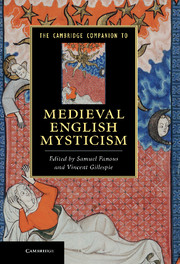Book contents
- Frontmatter
- Contents
- List of contributors
- Preface
- Chronology
- List of abbreviations
- 1 Introduction
- 2 c. 1080–1215: culture and history
- 3 c. 1080–1215: texts
- 4 1215–1349: culture and history
- 5 1215–1349: texts
- 6 1349–1412: culture and history
- 7 1349–1412: texts
- 8 1412–1534: culture and history
- 9 1412–1534: texts
- 10 1534–1550s: culture and history
- 11 1534–1550s: texts
- Guide to further reading
- Glossary of theological terms
- Index
- References
4 - 1215–1349: culture and history
Published online by Cambridge University Press: 28 July 2011
- Frontmatter
- Contents
- List of contributors
- Preface
- Chronology
- List of abbreviations
- 1 Introduction
- 2 c. 1080–1215: culture and history
- 3 c. 1080–1215: texts
- 4 1215–1349: culture and history
- 5 1215–1349: texts
- 6 1349–1412: culture and history
- 7 1349–1412: texts
- 8 1412–1534: culture and history
- 9 1412–1534: texts
- 10 1534–1550s: culture and history
- 11 1534–1550s: texts
- Guide to further reading
- Glossary of theological terms
- Index
- References
Summary
Lights, music, action:
The greatest Roman noblemen, swathed in silk and purple, preceded [the pope] to the accompaniment of drum and chorus, strings and organ, and the resounding harmonies of trumpets, and an infinite multitude of clerics and people followed.…Uncounted lanterns, suspended on ropes throughout the streets and alleys, strove to make the brightness of that day succumb to the brilliance of their own light. The number of banners and pieces of purple cloth, which were unfolded on the houses and the high towers of the Romans, cannot be estimated at all.
This vivid scene marked the beginning of the Fourth Lateran Council of 1215, a carefully-orchestrated event which was the crowning glory of Innocent III's pontificate (he died a year later). Unfortunately, the council did not get off to a good start as far as the English Church was concerned, since, just as the archbishop of Canterbury, Stephen Langton, was setting off to attend it, his powers were suspended by Innocent's representatives, as a punishment for his failure to publish the papal bull censuring England's barons for forcing their king to assent to Magna Carta. However, Langton was able to return from exile to his See in 1218, when both Innocent and John were dead. And the zeal with which English clergymen sought to implement the pope's decrees was undiminished.
- Type
- Chapter
- Information
- The Cambridge Companion to Medieval English Mysticism , pp. 69 - 90Publisher: Cambridge University PressPrint publication year: 2011



